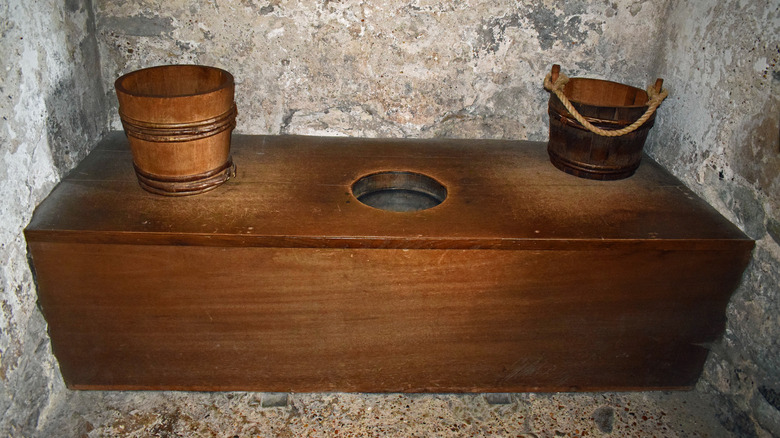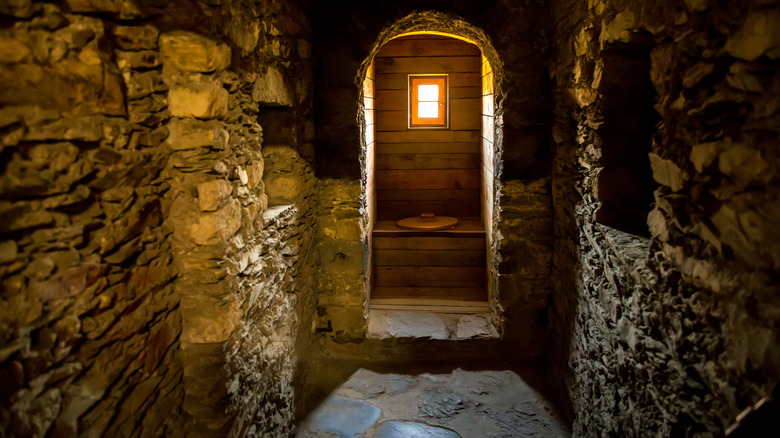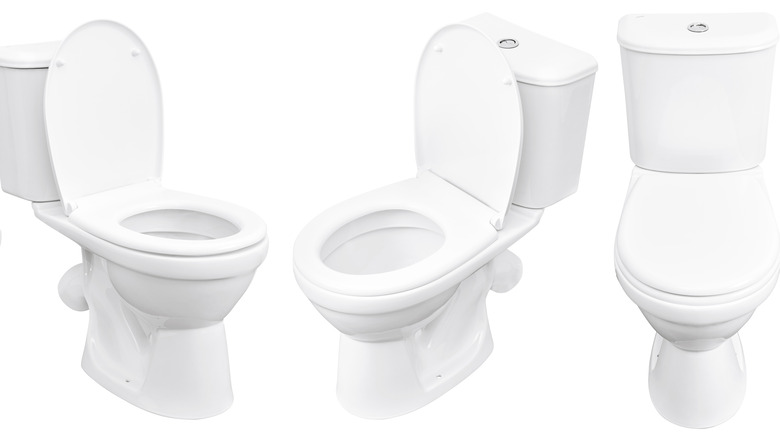Here's How You Went To The Bathroom In Medieval Castles
Smithsonian Magazine writes that prior to the modernization of toilets, outhouses, chamber pots, and holes dug in the ground were the norm when it came to using the bathroom. Portland Loo writes that the first indoor toilet was believed to have been created in Scotland in around 3000 B.C. Reel Paper goes on to describe that societies in Scotland, the Indus Valley (modern-day Pakistan and India), and Mesopotamia all had sewage and plumbing systems. However, not everyone had access to privacy.
In Ancient Rome, for example, shared public toilets were standard (via Porch). In fact, it was commonplace to socialize while using the toilet. To wipe, they used a shared sea sponge on a stick (per Smithsonian Magazine). Sapiens reports that although their toilets did not flush, a stream of water beneath the toilet disposed of the waste into a sewer. For one reason or another, these sewage systems were eventually replaced by other means in medieval times.
Public toilets in this time period were said to be built on bridges, so that the waste would fall below into a body of water (like a river). Per the World History Encyclopedia, a private medieval toilet was referred to as a garderobe. These were housed in a compact closet-like structure within a castle. Additionally, they featured a wooden or stone seat. These bathrooms were built into the wall of any castle and could easily be distinguished when viewed from the outside. As All That's Interesting explains, there were various ways the waste was disposed of. In some cases, it even meant employment.
Medieval hygiene was not as bad as one thinks
The World History Encyclopedia reports that when one used a garderobe, the waste went directly into a river or a moat. All That's Interesting writes that in some instances, the waste ended up in a pit via a gutter. In that case, an individual known as a gong farmer would clean these pits out frequently (via The Nonfiction Minute). Because of the smell, they worked at night and often lived outside of town. Per Designing Buildings, it was ensured that if these gutters came close to the ground, they had some kind of protection, as they were used to invade Chateau Gaillard in France in 1203. After that, walls were often built around them.
Because toilet paper did not exist, hay, grass, or even moss was used to do the job. To get rid of the smell in the garderobe, the structure usually had a small window and lacked doors. Additionally, herbs were used to counteract any odors. Nonetheless, medieval hygiene was not great but it wasn't horrible. Hand washing and bathing were common (per About History).
Healthy Way explains that people in medieval times simply did not have the luxury of bathing every day, and if they did bathe, they had to share the bath water with others. Although the cities did reek of excrement, this was due to a lack of a proper sewage system and less because people were using the bathroom anywhere they pleased. However, If public bathrooms were not readily available, it was inevitable for waste to be dumped on the streets (buckets were used as toilets by the poor).
The first flushable toilet was invented in the 16th century
According to All That's Interesting, garderobes eventually became obsolete because of the smell they produced. Reel Paper writes that they were replaced by chamber pots. This item looks like a dish but was used as a receptacle for human waste (via Love to Know). Its contents would then be dumped outside. History reports that Sir John Harington invented the first flushable toilet in 1596. He used nearly eight gallons of water from a reservoir located upstairs to flush the toilet. Harington was the godson of Queen Elizabeth I. He reportedly introduced his invention to the queen but she was put off by how much noise it made (per Brubaker Inc.).
In 1775, Scottish inventor Alexander Cummings patented flush toilets and created an S-shaped pipe. According to History of Yesterday, this prevented smells and bugs from emanating from beneath the toilet. Despite this, Smithsonian Magazine explains, flushable toilets did not gain popularity until 1851. Ultimately, people realized that sanitation conditions could be improved and the spread of disease controlled somewhat with the use of indoor plumbing and flushable toilets.
Thomas Crapper, an inventor from the 1800s, is credited with perfecting (though not inventing) the modern toilet. Per Mental Floss, Crapper is known for creating the ballcock, a mechanism that stops water from a toilet tank from overflowing. This valve is still widely used today (via Toiletology). History reports toilet paper became commercially available in 1857 and was heavily improved by the 1930s. However, the first reference to paper being used for cleansing dates back to China in the sixth century.


